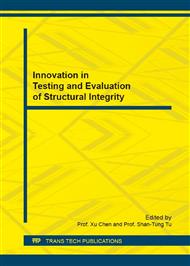[1]
Y. Cao, F. Ernst, G.M. Michal, Colossal carbon supersaturation in austenitic stainless steels carburized at low temperature, Acta Mater. 51 (2003) 4171-4181.
DOI: 10.1016/s1359-6454(03)00235-0
Google Scholar
[2]
R.H.V.D. Jagt, B.H. Kolster, M.W.H. Gillham, Anti-wear/corrosion treatment of finished austenitic stainless steel components: the Hardcor process, Mater. Design 12 (1991) 41-46.
DOI: 10.1016/0261-3069(91)90091-h
Google Scholar
[3]
T.L. Christiansen, T.S. Humelshøj, M.A.J. Somers, Gaseous carburising of self-passivating Fe-Cr-Ni alloys in acetylene-hydrogen mixtures, Surf. Eng. 27 (2011) 602-608.
DOI: 10.1179/1743294411y.0000000006
Google Scholar
[4]
K. Aoki, K. Kitano, Surface hardening for austenitic stainless steels based on carbon solid solution, Surf. Eng. 18 (2002) 462-464.
DOI: 10.1179/026708402225010038
Google Scholar
[5]
Y. Sun, X. Li, T. Bell, Low temperature plasma carburising of austenitic stainless steels for improved wear and corrosion resistance, Surf. Eng. 15 (1999) 49-54.
DOI: 10.1179/026708499322911647
Google Scholar
[6]
Y. Sun, X. Li, T. Bell, Structural characteristics of low temperature plasma carburised austenitic stainless steel, Mater. Sci. Technol. 15 (1999) 1171-1178.
DOI: 10.1179/026708399101505077
Google Scholar
[7]
M. Smaga, F. Walther, D. Eifler, Deformation-induced martensitic transformation in metastable austenitic steels, Mater. Sci. Eng. A 483-484 (2008) 394-397.
DOI: 10.1016/j.msea.2006.09.140
Google Scholar
[8]
T. Shintani, Y, Murata, Evaluation of the dislocation density and dislocation character in cold rolled Type 304 steel determined by profile analysis of X-ray diffraction, Acta Mater. 59 (2011) 4314-4322.
DOI: 10.1016/j.actamat.2011.03.055
Google Scholar
[9]
L-E. Lindgren, K. Domkin, S. Hansson, Dislocations, vacancies and solute diffusion in physical based plasticity model for AISI 316L, Mech. Mater. 40 (2008) 907-919.
DOI: 10.1016/j.mechmat.2008.05.005
Google Scholar
[10]
M. Eskandari, A. Najafizadeh, A. Kermanpur, Effect of strain-induced martensite on the formation of nanocrystalline 316L stainless steel after cold rolling and annealing, Mater. Sci. Eng. A 519 (2009) 46-50.
DOI: 10.1016/j.msea.2009.04.038
Google Scholar
[11]
F. Bottoli, G. Winther, T.L. Christiansen, M.A.J. Somers, Influence of plastic deformation on low-temperature surface hardening of austenitic stainless steel by gaseous nitriding, Metall. Mater. Trans. A 46 (2015) 2579-2590.
DOI: 10.1007/s11661-015-2832-5
Google Scholar
[12]
L. Shen, L. Wang, Y. Wang, C. Wang, Plasma nitriding of AISI 304 austenitic stainless steel with pre-shot peening, Surf. Coat. Technol. 204 (2010) 3222-3227.
DOI: 10.1016/j.surfcoat.2010.03.018
Google Scholar
[13]
Y. Zhu, R. Fu, F. Wei, The effect of room temperature deformation on carburizing, carbonitriding and ion nitriding process of steel, Heat treat. Metals, 1 (1990) 12-16.
Google Scholar
[14]
K. Nohara, Y. Ono, N. Ohasi, Composition and grain size dependencies of strain-induced martensitic transformation in metastable austenitic stainless steels, J. Iron Steel Inst. Jpn., 63 (1977) 772-782.
DOI: 10.2355/tetsutohagane1955.63.5_772
Google Scholar
[15]
G.K. Williamson, W.H. Hall, X-ray line broadening from field aluminium and wolfram, Acta Metall. Mater. 1 (1953) 22-31.
DOI: 10.1016/0001-6160(53)90006-6
Google Scholar
[16]
M. Deutges, H.P. Barth, Y. Chen, C. Borchers, R. Kirchheim, Hydrogen diffusivities as a measure of relative dislocation densities in palladium and increase of the density by plastic deformation in the presence of dissolved hydrogen, Acta Mater. 82 (2015).
DOI: 10.1016/j.actamat.2014.09.013
Google Scholar
[17]
G.K. Williamson, R.E. Smallman, Dislocation densities in some annealed and cold-worked metals from measurements on the X-ray debye-scherrer spectrum, Philos. Mag. 1 (1956) 34-36.
DOI: 10.1080/14786435608238074
Google Scholar
[18]
G. Dini, R. Ueji, A. Najafizadeh, S.M. Monir-Vaghefi, Flow stress analysis of TWIP steel via the XRD measurement of dislocation density, Mater. Sci. Eng. A 527 (2010) 2759-2763.
DOI: 10.1016/j.msea.2010.01.033
Google Scholar
[19]
Y. Hanlumyuang, P.A. Gordon, T. Neeraj, D.C. Chrzan, Interactions between carbon solutes and dislocations in bcc iron, Acta Mater. 58 (2010) 5481-5490.
DOI: 10.1016/j.actamat.2010.06.024
Google Scholar
[20]
S. Allain, O. Bouaziz, J.P. Chateau, Thermally activated dislocation dynamics in austenitic FeMnC steels at low homologous temperature, Scripta Mater. 62 (2010) 500-503.
DOI: 10.1016/j.scriptamat.2009.12.026
Google Scholar


